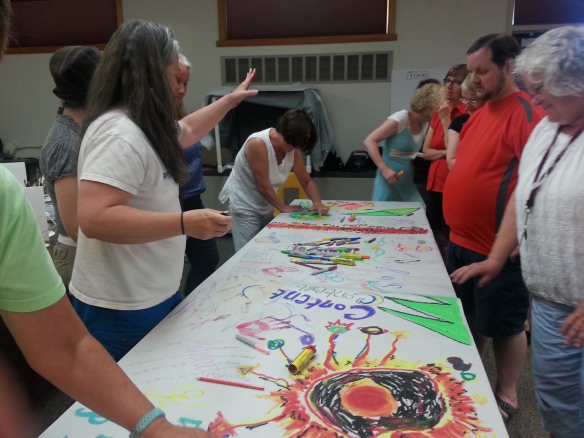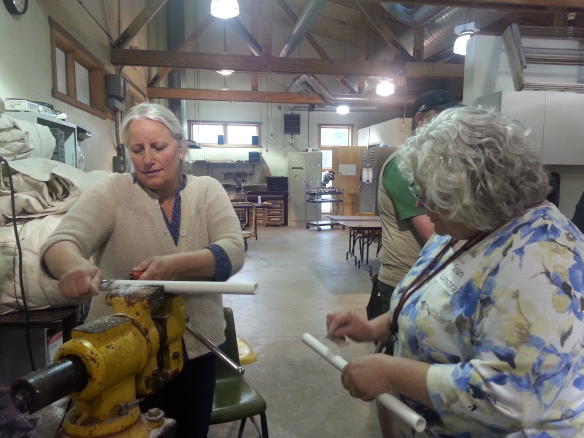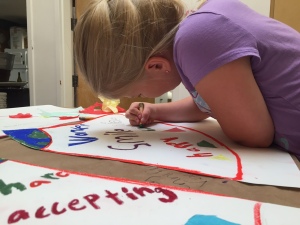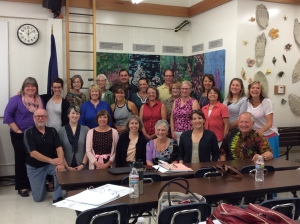
Teacher Leaders in the Arts candidates create a mural to define the qualities of leadership.
Imagine teaching juggling for brain development. Dancing the Underground Railroad to learn history. Playing improvisation games to build confidence. Painting stretched deer hide with natural pigments to understand culture. These are just a few of the deep arts learning experiences a group of 16 teachers immersed themselves in last summer at the Montana Teacher Leaders in the Arts Summer Institute at Salish Kootenai College.
Building on the success of the pilot program, the Montana Art Council and the Montana Office of Public Instruction will once again partner for the 2016-2017 Montana Teacher Leaders in the Arts program. Through this innovative professional learning program, MAC and the OPI seek to develop teacher leaders who can support teachers in K-12 public schools statewide in integrating the arts into their classrooms. The application process is now open to all K-12 Montana educators with a deadline of March 30, 2016.
The pilot cohort of Montana Teacher Leaders in the Arts totaled sixteen educators, including music specialists, visual arts specialists, elementary classroom teachers and one special education teacher. Schools represented included AA high schools, several Class C schools, six reservations schools, and even one of Montana’s one-room schoolhouses.
Susan Luinstra teaches eight students at tiny Bynum School along the Rocky Mountain Front: “The Teacher Leaders in the Arts Program opened my eyes to the importance and ease with which art can be integrated into our classroom curricula each day. Art connections are everywhere!”

Creating flutes from alternative materials under the guidance of SKC and TLA faculty member Frank Finley.
“Many of us work in buildings where there is limited to no access to arts specialists, so the chance to exchange ideas, learn new things, and gain advocates is invaluable,” says pilot cohort member Jodi Delaney, who teaches upper elementary Montessori at Broadwater Elementary School in Helena.
Teacher Leaders in the Arts candidates complete a rigorous program that includes a nine-day, on-site summer institute at Salish Kootenai College on the Flathead Reservation. This year’s summer program is scheduled for June 20-29, 2016 and will be lead by members of the pilot cohort, along with master instructors in arts learning, including Salish Kootenai College instructor Frank Finley. Guest workshops and field trips are also part of the summer workshop.

At the Tribal Warrior Monument in Pablo with creator and artist Corky Clairmont.
During the school year the program continues through a webinar series and online meetings with cohort members, as well as a final gathering in April. Candidates also receive support for a field project in the teacher leader’s school or region.
During the Teacher Leaders in the Arts program, candidates:
- gather arts-based tools to spark creative, engaged, and joyful teaching and learning for all learners, in any classroom environment.
- study the relationship between arts learning and brain theory.
- understand how the arts build critical habits of mind that lead to future success.
- work collaboratively with other educators to build a curriculum that supports an arts-integrated learning model.
- advocate for and champion arts learning back in their schools and communities by sharing their knowledge and skills with other educators.
- become catalysts for change to create more equitable access to arts learning opportunities for K-12 students in Montana schools.
“The program impacted my teaching in ways I did not expect,” says Jennifer Ogden, arts specialist from Victor, “It was nice to be able to meet and swap strategies with ‘Magic Teachers’ across the state who work in different kinds of schools.”

Guest workshop on integrating movement in the classroom with UM Dance Professor Karen Kaufmann.
Through the Montana Teacher Leaders in the Arts program, MAC and the OPI hope to build a strong network of coaches, mentors and advocates for arts learning across the state. This network of “Magic Teachers” will be able to provide professional learning and leadership on a local, regional and state level, increasing the available resources teachers can call on to help integrate the arts into their curriculum.
All teachers in Montana K-12 public schools, administrators, teaching artists and retired teachers are eligible to apply. Find all registration information and materials here.
Questions? Contact Emily Kohring at ekohring@mt.gov or 406-444-6522.




